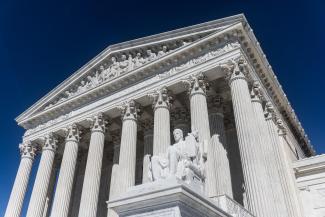With all the focus over the past few months on the West Virginia v. EPA case, and the rise of the Major Questions Doctrine in Chief Justice Roberts’s opinion, Thomas W. Merrill’s new book The Chevron Doctrine—Its Rise and Fall, and the Future of the Administrative State provides a refreshing reminder of why the Chevron doctrine is (was?) so popular. The book also provides us with an analysis of some of the doctrine’s weaknesses, which likely led to its relegation to judicial purgatory, for the moment, at the Supreme Court.
A professor at Columbia Law School, Merrill is a renowned scholar on Chevron. His book is a balanced account of the history of the doctrine, and provides a nuanced critique. The book helpfully provides some suggestions as to how the doctrine could be improved and reformed in the future.
Far from relegating Chevron to the dust bin, Merrill’s work reminds us of the judicial uncertainty that preceded the doctrine, why its perceived simplicity was so attractive to lower courts, and how that ease actually masked significant confusion within the terms included in the doctrine itself. Merrill then provides us with some potential ways forward that could improve the doctrine, while hewing to important principles of accountability.
Professor Merrill’s work is complex and at times humorous (not easy to achieve in the sometimes dry world of administrative law). It is a refreshing reminder of why the Chevron doctrine has, until very recently, enjoyed such popularity within the judiciary.
The book opens with a foundational chapter that reminds us of the four important values which should form part of judicial review of agency interpretations of statutes. These are the promotion of the rule of law, the sustenance of constitutional values, the channeling of interpretations that entail discretionary policy choices toward more politically accountable institutions (Congress and the executive branch), and finally, the creation of incentives for agencies to make better interpretive choices over time. Together, these values act as a touchstone for Merrill’s praise, and critique, of Chevron, and his articulation, in later chapters, of how the doctrine could be amended and improved.
The opening chapter charts the rise, through several administrations, in executive power, with recent presidents creating quasi-agencies through memorandums of understanding, inter-agency task forces, and powerful enforcement guidelines. Merrill also notes that a certain amount of “policy drift” on behalf of agencies is inevitable, as statutes age but regulatory problems only increase in urgency and complexity.
Within this context, Merrill’s bottom line is that if the agency is not undermining settled expectations, and is acting within the scope of its delegated authority, then the decision over discretionary interpretive choices is one the agency, not the court, should take. The corollary to this, however, is that agencies should make better interpretive decisions through the inclusion of public participation—thus, judicial deference should be conditioned upon the agency’s subjecting its own interpretations to public scrutiny. Merrill comes back to these values in his recommendations at the end of the book.
Before then, the author provides a detailed account of the pre-Chevron factors, which, in his words, neither individually nor collectively could be described as “coherent doctrine,” and then provides an insightful analysis of the decision itself.
Justice John Paul Stevens’s full opinion, as Merrill notes, is justly famous for its “emphatic affirmation of accountability values.” The justice’s text conditions deference to agencies on their superior political accountability—and makes clear that the sphere of agency policy choice is qualified by the requirement that Congress must have delegated policymaking responsibility to the agency. Finally, deference is due only when agencies act within the limits of that delegation.
However, the two most famous paragraphs of the decision (the fabled Chevron two-step) are not as consistent with the values found in the rest of the opinion. Under Step One, the court must determine whether Congress has directly spoken to the precise question at issue. If congressional intent is clear, the inquiry ends. At Step Two, the question for the court is whether the agency’s answer is based on a permissible construction of the statute. If it is, the court defers to the agency interpretation.
Merrill attributes the disconnect of the two-step from broader accountability values to the imprecision of the language used in the two steps. In his view, the rule-like articulation of the sequencing of the decision process contained in the two-step, and widely adopted by courts since then, does not appear in the body of the opinion itself as an organizing principle, and so is conceptually isolated.
This isolation separated the Chevron doctrine from the values it was originally tied to in the full opinion of Justice Stevens. In Merrill’s view, reading the doctrine as authorizing the same deferential standard of review to agency interpretations of “implicit” gaps as extended to explicit gaps in statutes has constituted the judicial authorization of a “revolution in the structure of American government”—transferring from the judiciary to the executive interpretive authority in any case involving ambiguity in a statute. Proponents of the idea of applying Chevron to implicit statutory gaps included Justice Antonin Scalia. In Merrill’s view, however, the approach is the greatest weakness of the doctrine because it ignores the Administrative Procedure Act itself, which requires de novo review by the courts of agency statutes.
Despite this weakness, the perceived simplicity of the Chevron doctrine was seen as a godsend by executive branch lawyers, and so the Department of Justice was an architect of the doctrine’s proliferation. As was Scalia; Merrill describes the justice’s early advocacy for the doctrine as having a largely negative effect on other members of the Court. The author describes some of Scalia’s opinions as “polemical.”
The problems with the two-step, according to Professor Merrill, lie with the words used in the doctrine. It is unclear whether, at step one, a court is supposed to only look at the text of the law being interpreted, or maybe other elements of the statute, or perhaps legislative history (as a stand in for congressional intent). But Scalia’s refusal to join any opinion that relied on legislative history meant that canon of statutory interpretation fell into disuse at the Supreme Court, and led to the rise of textualism. But it is also not clear, in the Chevron two-step, how clear the text of a statute must be.
The book charts Justice Scalia’s “lonely campaign” to make Chevron the universal standard for reviewing agency interpretations. This effort came to a head in City of Arlington v. FCC where, in one of the more humorous parts of the book, Merrill describes Scalia’s success in gaining a five-vote majority over a strong dissent by Justice Roberts.
Scalia and the D.C. Circuit interpreted the Chevron doctrine to mean that any ambiguity in a statute constituted an implied delegation to an agency interpretation. According to Merrill, this is precisely backward. In the professor’s view, the question, instead, should be whether there is persuasive evidence that Congress actually delegated authority to the agency to interpret the particular matter at hand. Toward the end of the book, Merrill says that independent judicial judgment should be a default assumption, unless Congress does in fact intend that the agency is to serve as the primary interpreter. Congress has illustrated the intention to bestow interpretive authority on agencies through broad statutory mandates, such as a directive to “protect public health” or establish “just and reasonable rates.”
In the absence of this intention, however, Merrill puts forward a proposed amendment (which he calls Chevron II) to the doctrine of mandatory acceptance. The idea is to apply deference only to agency actions that result from notice-and-comment rulemaking. He also proposes a new three-step regime of judicial review. First, the reviewing court should determine whether the agency’s interpretation falls within the boundaries of its delegated authority. Second, if it does, the next step would be to ask whether the agency interpretation violates any specific provision found in applicable legislation. Finally, if it does not, the court should ask whether the agency interpretation is a product of the notice-and-comment process. If these standards are met, the court should accept the agency interpretation as the proper exercise of discretionary choice. If the agency has not used notice-and-comment, the agency should still be entitled to the court’s respectful consideration of its interpretation, depending on whether it comports with settled expectations.
As Merrill notes, determining the boundaries of agency’s delegated authority is an extremely difficult task for courts. Having decisional guidance like the Chevron doctrine is therefore incredibly useful, provided that doctrine incorporates the foundational accountability values described above.
Professor Merrill’s account of the doctrine is a timely and refreshing read. It reminds us that the balance of power among courts, the executive branch, and Congress is a delicate one, and there are fully justified reasons why agencies should enjoy judicial deference. They are the more accountable body than the courts. But, as Merrill notes, judicial deference is not unlimited. Agencies should, in fact, act in politically accountable ways by including public participation in their processes.
Time will tell what the future holds for the Chevron doctrine. At the moment, there do not seem to be sufficient votes on the Supreme Court to kill it entirely, although it may suffer benign (or not so benign) neglect and decline for some time. As Professor Merrill reminds us, though, Chevron enjoyed significant judicial popularity for a reason, and it could be both reformed and reinvigorated to meet society’s ability to progress under the rule of law.
Lisa Benjamin is an associate professor at Lewis & Clark Law School.

